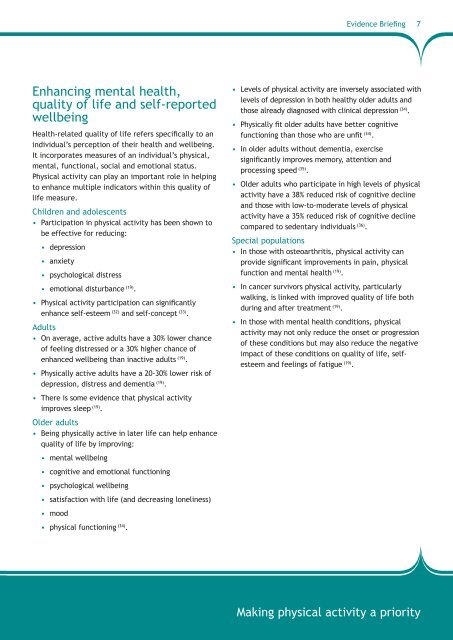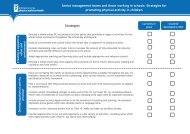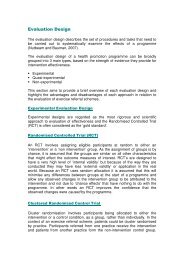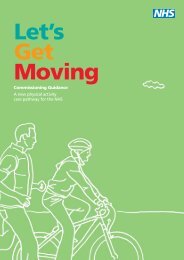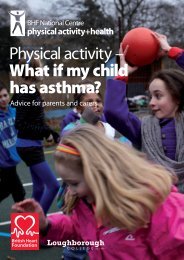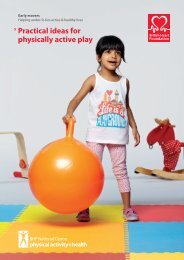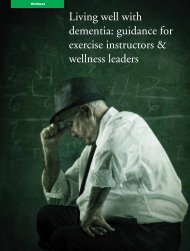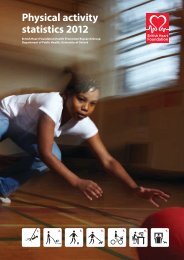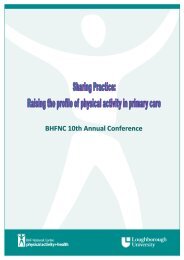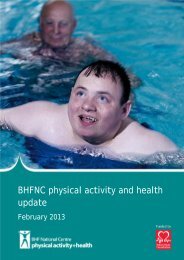Making the case for physical activity - BHF National Centre ...
Making the case for physical activity - BHF National Centre ...
Making the case for physical activity - BHF National Centre ...
Create successful ePaper yourself
Turn your PDF publications into a flip-book with our unique Google optimized e-Paper software.
Evidence Briefing7Enhancing mental health,quality of life and self-reportedwellbeingHealth-related quality of life refers specifically to anindividual’s perception of <strong>the</strong>ir health and wellbeing.It incorporates measures of an individual’s <strong>physical</strong>,mental, functional, social and emotional status.Physical <strong>activity</strong> can play an important role in helpingto enhance multiple indicators within this quality oflife measure.Children and adolescents• Participation in <strong>physical</strong> <strong>activity</strong> has been shown tobe effective <strong>for</strong> reducing:• depression• anxiety• psychological distress• emotional disturbance (19) .• Physical <strong>activity</strong> participation can significantlyenhance self-esteem (32) and self-concept (33) .Adults• On average, active adults have a 30% lower chanceof feeling distressed or a 30% higher chance ofenhanced wellbeing than inactive adults (19) .• Physically active adults have a 20-30% lower risk ofdepression, distress and dementia (19) .• There is some evidence that <strong>physical</strong> <strong>activity</strong>improves sleep (19) .Older adults• Being <strong>physical</strong>ly active in later life can help enhancequality of life by improving:• mental wellbeing• cognitive and emotional functioning• psychological wellbeing• satisfaction with life (and decreasing loneliness)• mood• <strong>physical</strong> functioning (34) .• Levels of <strong>physical</strong> <strong>activity</strong> are inversely associated withlevels of depression in both healthy older adults andthose already diagnosed with clinical depression (34) .• Physically fit older adults have better cognitivefunctioning than those who are unfit (34) .• In older adults without dementia, exercisesignificantly improves memory, attention andprocessing speed (35) .• Older adults who participate in high levels of <strong>physical</strong><strong>activity</strong> have a 38% reduced risk of cognitive declineand those with low-to-moderate levels of <strong>physical</strong><strong>activity</strong> have a 35% reduced risk of cognitive declinecompared to sedentary individuals (36) .Special populations• In those with osteoarthritis, <strong>physical</strong> <strong>activity</strong> canprovide significant improvements in pain, <strong>physical</strong>function and mental health (19) .• In cancer survivors <strong>physical</strong> <strong>activity</strong>, particularlywalking, is linked with improved quality of life bothduring and after treatment (19) .• In those with mental health conditions, <strong>physical</strong><strong>activity</strong> may not only reduce <strong>the</strong> onset or progressionof <strong>the</strong>se conditions but may also reduce <strong>the</strong> negativeimpact of <strong>the</strong>se conditions on quality of life, selfesteemand feelings of fatigue (19) .<strong>Making</strong> <strong>physical</strong> <strong>activity</strong> a priority


